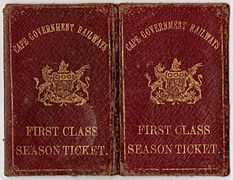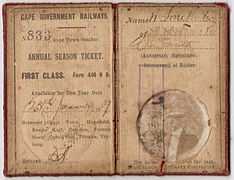South African Class 6J 4-6-0
| South African Class 6J 4-6-0 ex CGR 6th Class 4-6-0 | |
|---|---|
|
Ex CGR 6th Class no. 292, SAR Class 6J no. 642 | |
| Type and origin | |
| Power type | Steam |
| Designer | Cape Government Railways |
| Builder | Neilson, Reid and Company |
| Serial number | 6089-6102 |
| Model | CGR 6th Class |
| Build date | 1902 [1] |
| Total produced | 14 |
| Specifications | |
| Configuration | 4-6-0 "Tenwheeler" |
| Gauge | 3 ft 6 in (1,067 mm) Cape gauge |
| Leading wheel diameter | 28.5 in (724 mm) |
| Driver diameter | 54 in (1,370 mm) |
| Wheelbase |
Total: 45 ft 8.5 in (13.932 m) Engine: 5 ft 6 in (1.676 m) bogie 11 ft 4 in (3.454 m) coupled 20 ft 8 in (6.299 m) total Tender: 4 ft 7 in (1.397 m) bogie 14 ft 7 in (4.445 m) total |
| Length | 53 ft (16.154 m) |
| Height | 12 ft 10 in (3.912 m) |
| Frame | Bar frame |
| Axle load | 13 long tons (13.2 t) on 2nd driver |
| Weight on drivers | 37.5 long tons (38.1 t) |
| Locomotive weight | 48.8 long tons (49.6 t) |
| Tender weight |
44,032 lb (20.0 t) empty 43.05 long tons (43.7 t) w/o |
| Locomotive and tender combined weight |
99,120 lb (45.0 t) empty 91.85 long tons (93.3 t) w/o |
| Tender type |
XF - XC, XC1, XD, XE, XE1, XF, XF1, XF2, XJ, XM, XM1, XN2, XM3, XM4 permitted * 2 axle bogies * 34 in (864 mm) wheels * Length 22 ft 2.5 in (6.769 m) |
| Fuel type | Coal |
| Fuel capacity | 10 long tons (10.2 t) |
| Water capacity | 3,000 imp gal (14,000 l) |
| Boiler |
4 ft 7 in (1.397 m) inside diameter 11 ft 2.125 in (3.407 m) inside length 6 ft 9.5 in (2.070 m) pitch |
| Boiler pressure | 180 psi (1,240 kPa) |
| Firegrate area | 19 sq ft (1.765 m2) |
| Heating surface: – Tubes |
182 tubes 2 in (50.8 mm) diameter 1,065 sq ft (98.942 m2) |
| – Firebox | 108 sq ft (10.034 m2) |
| – Total | 1,173 sq ft (108.975 m2) |
| Cylinders | Two |
| Cylinder size |
17 in (432 mm) bore 26 in (660 mm) stroke |
| Valve gear | Stephenson |
| Performance figures | |
| Tractive effort |
At 75% pressure: [2] 18,780 lbf (83.5 kN) at 180 psi (1,240 kPa) 17,740 lbf (78.9 kN) at 170 psi (1,170 kPa) |
| Career | |
| Operator(s) |
Cape Government Railways South African Railways |
| Class | CGR 6th Class, SAR Class 6J |
| Number in class | 14 |
| Number(s) |
CGR 155, 160, 287-294, 537-540 SAR 635-648 [1][3][4] |
| Delivered | 1902 |
| First run | 1902 |
| Withdrawn | 1973 [5] |
The South African Class 6J 4-6-0 of 1902 is a South African steam locomotive from the pre-Union era in the Cape Colony.
In 1902 fourteen 6th Class bar framed steam locomotives with a 4-6-0 wheel arrangement were placed in service by the Cape Government Railways. In 1912, when they were assimilated into the South African Railways, they were renumbered and reclassified to Class 6J.[1][3][5]
Manufacturer
The 6th Class was designed at the Salt River works of the Cape Government Railways (CGR) at the same time as the 7th Class. While the 7th Class was conceived primarily as a goods locomotive, the 6th Class was intended to be its fast passenger service counterpart.[1]
The fourteen 6th Class locomotives that were placed in service by the CGR in 1902 were built by Neilson, Reid and Company. They were practically identical to the two bar framed locomotives built by Sharp Stewart and Company in 1900 that became the South African Railways (SAR) Class 6F, and they were visually identifiable as second generation 6th Class locomotives by their higher running boards without driving wheel fairings.[1][2]
Distribution
Four of them were numbered in the range from 537 to 540 for the Midland System of the CGR. The other ten were numbered 155, 160 and in the range from 287 to 294 for the Western System.[1][4]
It would appear that the CGR’s Western System was more concerned with having unbroken number ranges than the CGR itself was about allocating different classifications to dissimilar locomotives, even when they had different wheel arrangements. Of these Western System engine numbers, 155 and 160 had been used before on two 6th Class locomotives that had been sold to the Oranje-Vrijstaat Gouwerment-Spoorwegen (OVGS) in 1897.[1][4]
Class 6 sub-classes
The Union of South Africa was established on 31 May 1910, in terms of the South Africa Act. One of the clauses in the Act required that the three Colonial Government railways, the CGR, the Natal Government Railways and the Central South African Railways, also be united under one single administration to control and administer the railways, ports and harbours of the Union. While the South African Railways (SAR) came into existence in 1910, the actual classification and renumbering of all the rolling stock of the three constituent railways required careful planning and was only implemented with effect from 1 January 1912.[3][6]
When these fourteen locomotives were assimilated into the SAR in 1912, they were renumbered in the range from 635 to 648 and reclassified to Class 6J.[2][3][4]
The rest of the CGR’s 6th Class locomotives, together with the Central South African Railways (CSAR) Classes 6-L1 to 6-L3 locomotives that had been inherited from the OVGS via the Imperial Military Railways (IMR), were grouped into thirteen more sub-classes by the SAR. The 4-6-0 locomotives became SAR Classes 6, 6A to 6H, 6K and 6L, the 2-6-2 locomotives became Class 6Y and the 2-6-4 locomotives became Class 6Z.[2][3][4]
Service
The Class 6J has been described as the most successful of the bar framed 6th Class locomotives. The CGR placed them in service on the Cape mainline and for several years they hauled the Dining Car Express Train that left Cape Town every Wednesday morning for the Orange River Colony and Johannesburg in the Transvaal, running via De Aar, Noupoort and Springfontein.[1][5]
The last Class 6J locomotive was withdrawn from service in Bethlehem in 1972.[5]
Renumberings
The table shows the Class 6J works numbers and renumberings.[1][3][4]
| Works no. |
CGR no. |
CGR Sys. |
SAR no. |
Notes |
|---|---|---|---|---|
| 6097 | 155 | W | 635 | See Class 6 |
| 6098 | 160 | W | 636 | See Class 6 |
| 6089 | 287 | W | 637 | |
| 6090 | 288 | W | 638 | |
| 6091 | 289 | W | 639 | |
| 6092 | 290 | W | 640 | |
| 6093 | 291 | W | 641 | |
| 6094 | 292 | W | 642 | |
| 6095 | 293 | W | 643 | |
| 6096 | 294 | W | 644 | |
| 6099 | 537 | M | 645 | |
| 6100 | 538 | M | 646 | |
| 6101 | 539 | M | 647 | |
| 6102 | 540 | M | 648 | |
Liveries illustrated
The main picture shows CGR (Western System) 6th Class no. 292, later renumbered to SAR Class 6J no. 642, painted in the CGR's green livery on the Cape’s Dining Car Express Train. It is a colourised photograph that was used as a post card, on which some artistic licence had been used with red wheels and a red headlight reflector. The following picture shows one in SAR black livery in later years.[1]
Also illustrated is a first class annual season ticket, issued to Mr. W. Smith on 25 January 1909, that allowed the holder to travel between Cape Town and Hopefield, Eendekuil, Caledon, Franschhoek, Carnarvon, Prieska and Vryburg, literally all over the Western System lines in the Western Cape and into the Northern Cape Colony.
-
_ex_CGR_538.jpg)
Ex CGR 6th Class no. 538, SAR Class 6J no. 646
-

First class season ticket cover
-

First class season ticket inside
See also
- South African Class 6 4-6-0
- South African Class 6A 4-6-0
- South African Class 6B 4-6-0
- South African Class 6C 4-6-0
- South African Class 6D 4-6-0
- South African Class 6E 4-6-0
- South African Class 6F 4-6-0
- South African Class 6G 4-6-0
- South African Class 6H 4-6-0
- South African Class 6K 4-6-0
- South African Class 6L 4-6-0
- South African Class 6Y 2-6-2
- South African Class 6Z 2-6-4
- The 4-6-0 "Tenwheeler"
- Tender locomotive numbering and classification
- South African locomotive history
- List of South African locomotive classes
References
|
- ↑ 1.0 1.1 1.2 1.3 1.4 1.5 1.6 1.7 1.8 1.9 Holland, D.F. (1971). Steam Locomotives of the South African Railways, Volume 1: 1859-1910 (1st ed.). Newton Abbott, Devon: David & Charles. pp. 49–50, 56. ISBN 978-0-7153-5382-0.
- ↑ 2.0 2.1 2.2 2.3 South African Railways and Harbours Locomotive Diagram Book, 2’0” & 3’6” Gauge Steam Locomotives, 15 August 1941, as amended
- ↑ 3.0 3.1 3.2 3.3 3.4 3.5 Classification of S.A.R. Engines with Renumbering Lists, issued by the Chief Mechanical Engineer’s Office, Pretoria, January 1912, pp. 8, 12, 14, 33 (Reprinted in April 1987 by SATS Museum, R.3125-6/9/11-1000)
- ↑ 4.0 4.1 4.2 4.3 4.4 4.5 Holland, D.F. (1972). Steam Locomotives of the South African Railways, Volume 2: 1910-1955 (1st ed.). Newton Abbott, Devon: David & Charles. p. 138. ISBN 978-0-7153-5427-8.
- ↑ 5.0 5.1 5.2 5.3 Paxton, Leith; Bourne, David (1985). Locomotives of the South African Railways (1st ed.). Cape Town: Struik. pp. 41–44. ISBN 0869772112.
- ↑ The South African Railways - Historical Survey. Editor George Hart, Publisher Bill Hart, Sponsored by Dorbyl Ltd., Published c. 1978, p. 25.
_CGR_6_292.jpg)